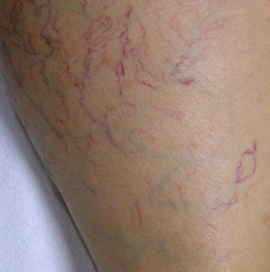 **Spider veins** are very fine dilations of the skin’s veins. These permanent expansions of the small intradermal veins of the lower limbs appear as small blue-violet or red threads on the legs, thighs, and feet.
**Spider veins** are very fine dilations of the skin’s veins. These permanent expansions of the small intradermal veins of the lower limbs appear as small blue-violet or red threads on the legs, thighs, and feet.
Present in both women and men, spider veins are difficult to treat due to their varying diameter and depth (usually between 0.1 mm and 3 mm wide).
They usually reflect a phenomenon called venous stasis, which is an early sign of venous insufficiency. Spider veins are narrower and more superficial than varicose veins, but they’re fundamentally similar.
They can be associated with larger varicose veins or even with swelling (often more noticeable in the evening).
Certain factors predispose people to developing them or make them progress faster: heredity, exposure to cold or heat, rapid temperature changes, local corticosteroid treatments, and anything that increases blood pressure (stress, emotion, or physical exertion).
How can spider veins on the legs be treated?
Spider veins can be treated with lasers, provided there is no severe underlying venous insufficiency, which would otherwise lead to rapid recurrence. That’s because spider veins and varicose veins are part of a chronic and progressive condition.
The needle injection technique (sclerotherapy) is often the first-line treatment for spider veins and their feeder veins. It’s performed by a phlebologist or angiologist, after a thorough assessment and mapping of the venous network in the legs using Doppler ultrasound.
Laser treatments are recommended for lower limb telangiectasias, especially when they are bluish, violet, and of small diameter. Lasers are also effective for very superficial, bright red spider veins that are arranged in dense patches or thin lines, as their diameter can make them inaccessible even to the finest needles (as small as 0.3 mm) used in micro-sclerotherapy.
Lasers can also be used when micro-sclerotherapy is ineffective (especially for red spider veins), or in cases of allergy or intolerance to sclerotherapy products.
Additionally, some areas like the ankles are ideal for laser treatment. Laser therapy is therefore complementary to other venous treatments (medical or surgical) and is mainly for spider veins that are too fine to be treated by needle.
Larger isolated varicose veins, which are tricky to treat with sclerotherapy, can also sometimes be treated with lasers as an alternative to surgery (phlebectomy).
How does laser treatment for spider veins work?
The Nd:YAG laser is a beam of monochromatic light whose target, in the context of spider vein treatment, is hemoglobin (the red pigment in blood) inside the superficial vessels. This light is converted into heat, which precisely destroys the vessels responsible for the visible veins. The main advantage of the laser is that it targets these red areas without affecting the surrounding skin.
Other benefits: there are no injections, no need for anesthesia, and no bandages or bruising afterward.
Laser treatment for spider veins is effective and usually requires fewer sessions than micro-sclerotherapy.
What happens during a consultation for spider veins?
At your first consultation with Dr. Benjamin Cozanet in Paris 1st, a clinical exam of the veins will be performed. You’ll also receive a prescription to have a venous Doppler ultrasound done before any treatment, to check the state of the underlying veins and to map out problem areas.
A quote for laser treatment and an information document will be given at the initial consultation and validated if the Doppler ultrasound confirms laser treatment is appropriate.
What happens during a laser session for spider veins?
The laser session involves a series of light pulses along the spider veins, which is felt as mild tingling or burning. Both the patient and Dr. Cozanet wear protective eyewear. Sessions last from 15 to 30 minutes depending on how many spider veins need treating. The treatment is only mildly uncomfortable, and most people tolerate it without any anesthesia. You can resume normal activity the same day.
Complete treatment may require 2 to 4 sessions spaced 6 to 8 weeks apart, with results usually visible 1 to 2 months after the laser session. Wearing compression stockings right after and regularly improves results.
Maintenance is recommended in the following years, as venous disease tends to progress.
What are the precautions and aftercare?
Before the laser session: The skin must be free from suntan or self-tanners, so avoid sun exposure and beta-carotene supplements for 4 weeks before your session. Patients on medication should mention it, as some drugs cause photosensitivity. Pregnant women should also inform their doctor.
After the laser session: You may experience mild redness or swelling for up to 48 hours after treatment.
Applying a healing cream is recommended for a few days after. Strict sun protection is essential for four weeks.
Dr. Cozanet’s Advice
Spider veins are an early sign of chronic venous insufficiency, and require comprehensive management by a specialist. It’s best to treat them as soon as possible for maximum effectiveness, ideally in winter.
Some good lifestyle habits should go along with treatments by Dr. Benjamin Cozanet:
- Avoid excess weight.
- Wear loose-fitting clothes and comfortable shoes.
- Stay out of the sun.
- Avoid inactivity—walk as much as possible.
- Exercise regularly.
- Wear compression stockings.
- Massage your legs regularly and elevate them while sleeping.
- Take venotonic medications to strengthen vein walls and partially prevent swelling. These also help reduce fatigue and heaviness in the legs and speed up the reduction of swelling.
Are there any complementary treatments?
Improving venous and lymphatic circulation in the legs can be boosted by strengthening muscle activity, which can be achieved using EMSculpt for the thighs and/or calves.
Laser and pulsed light treatments are also great for erythrosis, rosacea, fine red spider veins, angiomas, and cherry angiomas.
Skin aging also shows up as pigmentation spots and sagging skin, which can be treated with a photorejuvenation laser.
For targeted wrinkle treatment, hyaluronic acid injections can be used.
To find more about, you can visit websites:
Cryolipolysis CoolSculpting®
EMSCULPT Neo® & EDGE®
Ultherapy Prime®
EMFACE®
Hyaluronic Acid Restylane®
Hyaluronic Acid Juvederm®
SkinBoosters®
Sculptra®
Radiesse®
Peels
or contact Dr Benjamin Cozanet for any questions: Contact Us
or book a first complimentary consultation: Book an Apointment


